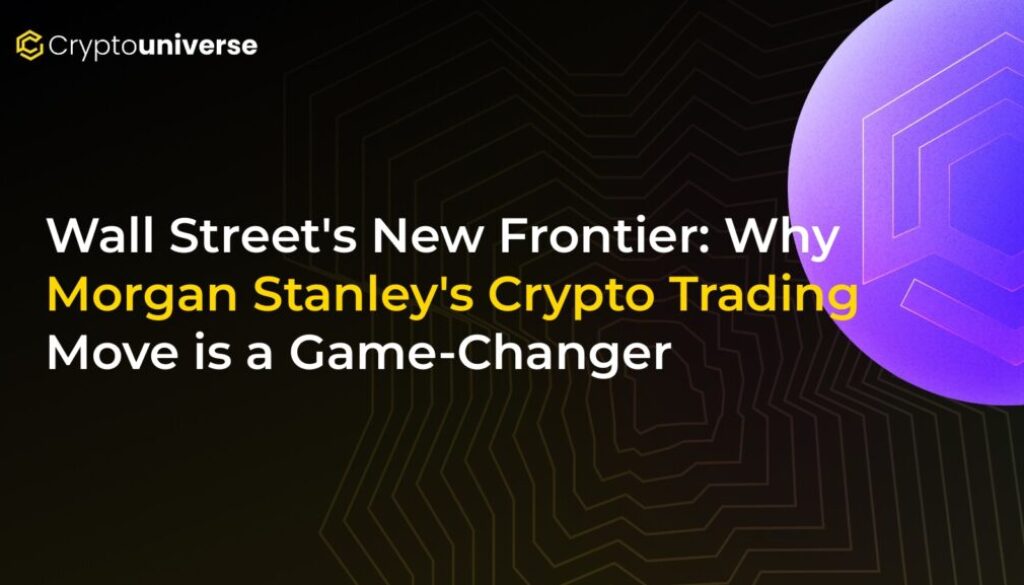Wall Street’s New Frontier: Why Morgan Stanley’s Crypto Trading Move is a Game-Changer

The Walls Between Wall Street and Crypto Are Crumbling
The financial world is buzzing with a seismic announcement: Morgan Stanley, a titan of traditional finance, is preparing to dive headfirst into the cryptocurrency market. The banking giant plans to launch a suite of Bitcoin trading services by mid-2026, marking a pivotal moment in the convergence of old-world banking and the new digital economy. This isn’t just another service offering; it’s a powerful signal of growing institutional confidence in digital assets, poised to reshape investment strategies for years to come.
For investors, tech innovators, and financial enthusiasts, understanding the implications of this move is crucial. As the line between traditional and digital finance blurs, a new landscape of opportunity and challenge is emerging.
What We Know: Morgan Stanley’s Crypto Playbook
Morgan Stanley’s strategy is centered around its E-Trade platform, a popular gateway for retail and affluent investors. By integrating crypto trading directly into this ecosystem, the firm aims to provide a seamless and secure entry point for its high-net-worth clients to gain direct exposure to digital assets like Bitcoin and Ethereum.
This strategic pivot accomplishes two key goals:
- Broadens Investment Horizons: It offers clients a direct path into a burgeoning asset class without needing to navigate third-party crypto exchanges.
- Enhances Market Stability: By bringing its considerable capital and client base into the fold, Morgan Stanley can significantly boost liquidity and potentially temper the notorious volatility of the crypto market.
The Institutional Domino Effect: A Trend Gains Momentum
Morgan Stanley is not acting in a vacuum. Its decision follows a series of bold moves by other financial behemoths like BlackRock and Fidelity, whose successful launches of Bitcoin ETFs have already legitimized cryptocurrency in the eyes of mainstream investors. The announcement of
This wave of institutional adoption is critical. Research consistently shows that increased participation from major financial players can lead to a more stable and mature market. This, in turn, builds confidence among a wider pool of investors, from retail traders to large-scale funds, creating a more robust and reliable financial ecosystem.
The Technology Powering the Push: A Partnership for Progress
To execute this ambitious plan, Morgan Stanley is not going it alone. The firm has forged a strategic partnership with Zerohash, a company specializing in digital asset trading and stablecoin infrastructure. This collaboration is designed to build a powerful and secure wallet solution for E-Trade clients, ensuring that crypto transactions are both simple and safe.
This technological foundation does more than just enable Bitcoin trading. It lays the groundwork for a future where traditional assets—such as stocks, bonds, and real estate—can be tokenized and traded on the blockchain. This move unlocks a world of possibilities for asset management, promising greater efficiency, transparency, and accessibility than ever before.
Navigating the Hurdles: Regulation and the Soul of Decentralization
As Wall Street embraces crypto, it inevitably brings the full weight of the regulatory world with it. While this can bring much-needed oversight and investor protection, it also raises critical questions for the Web3 community. Industry experts caution that the frameworks required for crypto-to-fiat operations could clash with the decentralized ethos that lies at the heart of the blockchain movement.
The primary concern is the potential centralization of crypto liquidity within a few major financial institutions. This could create friction and undermine the core principles of a peer-to-peer financial system. For the industry to thrive, a delicate balance must be struck between innovation and regulatory compliance, allowing startups and established players to coexist and grow.
The Future is Hybrid: What This Means for You
Morgan Stanley’s journey into cryptocurrency is more than a business decision; it’s a landmark event in financial history. It signals that digital assets are no longer a fringe experiment but are becoming an integrated part of modern wealth management. As other traditional institutions inevitably follow suit, the competitive dynamics of the investment world are set to be redefined.
For investors, this new era promises greater access, potentially higher stability, and a new suite of sophisticated financial products. The fusion of traditional finance and crypto is well underway, and Morgan Stanley is not just participating—it’s helping to steer the ship. The only question left is: how will you navigate this transformative wave?


